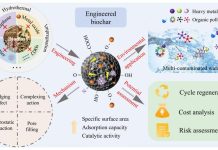Aarthi JanakiRaman, Research Director, Chemicals and Advanced Materials TechVision, Frost & Sullivan, charts the transition to a biobased economy, stressing the need for an integrated approach
Circularity has been the cornerstone of various global developmental efforts since the UN proposed the 2030 Agenda for Sustainable Development. The SDGs and their associated targets are the focus of multiple countries to move towards sustainable production, process strategies, and consumption with effective reuse and management, ensuring holistic health and wellness of the global population.
Countries have established national strategy plans and roadmaps to transition towards a circular economy. Europe has been at the forefront of its efforts to become the first climate-neutral continent and achieve net zero emissions by 2050.
From its Circular Economy Action Plan (CEAP) in 2015 to the current Circular Bio-based Europe Joint Undertaking (CBE JU), the focus has been on establishing a circular economy with an emphasis on sustainable research and circular product development.
A biobased and circular economy go together and adopting bio-based and renewable resources contributes significantly towards establishing a net zero economy.
A thriving bioeconomy heading for carbon neutrality
A bioeconomy is not restricted only by using bio-based renewable resources and feedstock for manufacturing and production; it also includes a transition to clean energy, establishing sustainable food production and agricultural systems, plus resource conservation, optimization and reuse during manufacturing and processing, amongst others.
Continued R&D efforts, technology development, and adoption are critical to a thriving bioeconomy and achieving carbon neutrality in all industrial and consumer sectors.
The European Commission is actively fostering an innovation ecosystem that is actively involved in research, testing, and deploying sustainable technologies that can reduce the dependence on fossil fuels and smoothen the transition to a cleaner and greener economy.
Various technological advances are being pursued that can help in sustainable socio-economic development, including:
Biotechnology advances
Due to their robust methodology and scale-up ability, fermentation technologies and biocatalysis are essential tools of interest. With advances in cloud-based fermentation and highly specific enzyme catalysis emerging, bioproducts with enhanced efficiency are expected during the next three to four years.
Omics technology and systems biology can increase the efficiency of cell factories and biorefineries. Most biotechnological processes such as fermentation, bioremediation, and metabolic engineering need omics technologies to understand biological systems and their functions to optimize yield and productivity and devise apt processing conditions.
Using computation tools and analytical data platforms to decipher complex data can help improve cell factories’ processes and design parameters.
Biomanufacturing
Biomanufacturing involves the integration of different biotechnology approaches, including genetic, protein, metabolic engineering, and synthetic biology.
Although these approaches are independent, they must be combined to achieve the desired product and functionalities.
Using biological processes in manufacturing encourages sustainability and holds significant global expansion possibilities for industrial stakeholders
Biomanufacturing uses less energy, fewer resources, and less chemical processing, and when economies of scale can be achieved, lower costs compared to traditional processes, especially in chemicals, pharma, life sciences and allied areas.
While most of its use is centred around the production of chemicals and biological molecules, mainly primary metabolites such as butanol, ethanol, acetone, and citric acid, secondary metabolites, and large biomolecules, it has the potential to be expanded for the development of materials, especially biopolymers, food and feed ingredients, engineered cells and tissues to name a few.
Although several biotechnology strategies exist, computational, molecular biology and fermentation tools are widely adopted in the chemicals industry to produce high-value chemicals and products.
An added advantage of using biomanufacturing processes, especially biorefineries, is the ability to produce value-added products. Bio-based energy in the form of biofuels, bioplastics, and materials can be synthesized to improve overall commercial economies of scale of bio-based alternatives.
Waste management and recycling are becoming vital components of a circular economy. Apart from chemical and mechanical recycling processes, emerging approaches such as enzymatic recycling, anaerobic digestion, bioremediation, and biofiltration are seeing increasing adoption in different types of waste treatment from residential and industrial facilities and treating end-of-life plastic products.
In addition, researchers are trying to use a combination of the approaches mentioned above to recycle multi-material-based products and packaging.
Apart from these, alternative feedstock, from plant biomass to byproducts of waste streams and gases captured from industrial and direct air emissions, can generate renewable energy, chemicals, and other value-added products, including agricultural inputs, packaging materials and feed ingredients, to name a select few.
Achieving a sustainable economy is complex
Achieving a sustainable economy requires the involvement of both public and private stakeholders; it needs the participation of various industries to establish a sustained growing economy.
While technological advances can ensure a smooth transition to a circular economy, large-scale deployment is often hindered due to a lack of timely support, clear guidelines, and consumer acceptance. It is, therefore, essential to devise a systemic approach involving stakeholders’ participation across the industrial value chains.
Under Horizon 2020, the Commission laid the groundwork for various research programs. It fostered innovations to help solve potential challenges and mitigate risks faced during the transition to a more circular economy. It is imperative to build on it.
Public-private partnerships are crucial in ensuring continuous R&D efforts and devising clear guidelines and standards for technology deployment, product development, and commercialization to prevent ambiguity and ensure consumer satisfaction.
An integrated approach will fast forward a biobased economy
A joint approach across industrial sectors with the active participation of non-profit, standardization agencies, and regional and national governments is needed to ensure successful industrial adoption.
An integrated approach will also help gain access to the requisite funding and help lower potential risks that might become a burden for a single stakeholder. It can also help stakeholders explore industry opportunities to increase profitability and market expansion.
Despite various initiatives that encourage multistakeholder involvement and continued focus on the commercialization of much-needed technologies for a bio-based European economy, the efforts still need to be more streamlined and spread across all sectors.
Dependence on non-renewable resources is still dominant, mainly due to price-performance issues, and sustainable technologies still face challenges related to scale and technical performance.
However, more focus towards capacity building, clearer guidelines and standards, knowledge sharing and information dissemination, and access to enabling technologies for product development can solve market and commercialization challenges towards a carbon-neutral Europe.











